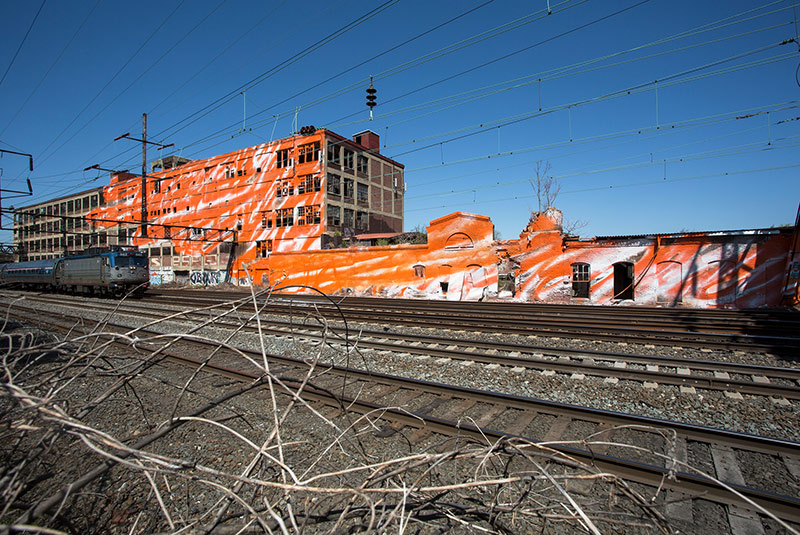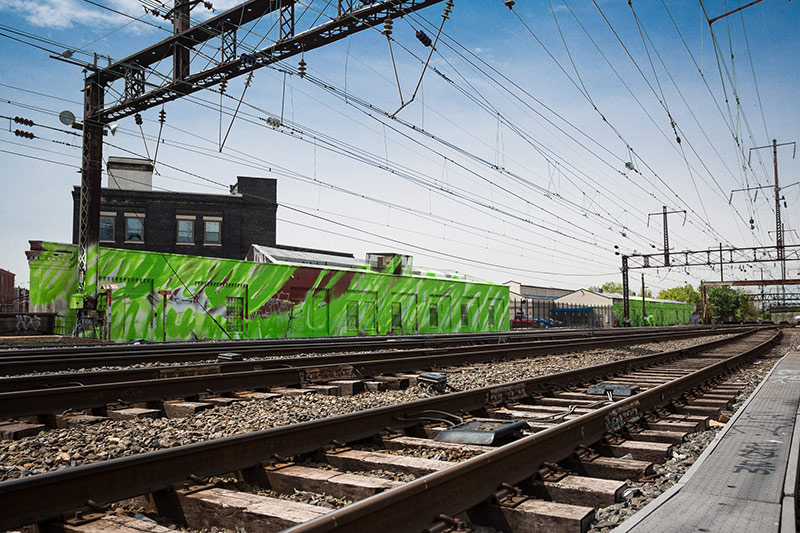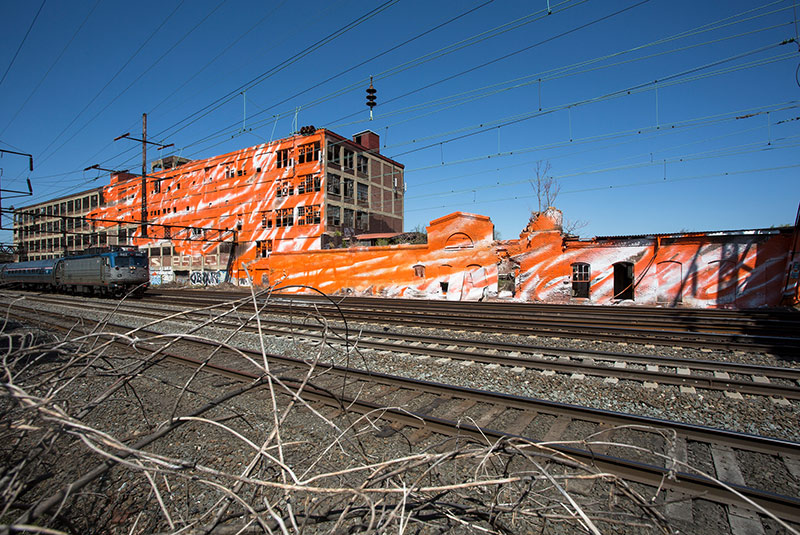
In Philly, an evolving art show attracts attention of rail riders with splashes of color
This article is cross-posted from KnightArts.org. Photos by Steve Weinik for the City of Philadelphia Mural Arts Program. More pics on Flickr.
The railroad corridor between New York’s Penn Station and Philadelphia’s 30th Street Station is well traveled with some 34,000 passengers daily. Typically there’s not much to look at, and riders sit immersed in laptops, newspapers or naps. But a striking new addition to the landscape is giving them a good reason to glance out the window: Intermingled with the graffiti, junk heaps and weedy slopes is a sequence of seven “murals,” together titled “psychylustro,” by the German artist Katharina Grosse.
Vibrant orange intercut with white diagonal stripes covers the facade of a multistory building, while a shocking pink coats a tattered fence, bare trees and even the grassy ground of a hill. Another section of earth is saturated with a distinctly unnatural green. The overall effect is as if Mark Rothko had gone on an outdoor acid trip while toting a giant spray gun filled with Day-Glo paint.
With funding from Knight Foundation and other benefactors, the City of Philadelphia Mural Arts Program commissioned Grosse to create the abstract mural stretching between the 30th Street and North Philadelphia stations. The artist explains via email that the candy colors were meant to be attention-getters. “I wanted the colors to be raw and artificial and to totally stand out as if they were sitting way in front of the sites,” she says.
Based in Berlin and a professor at the prestigious Kunstakademie in Dusseldorf, Grosse is known for spray painting prosaic matter, such as piles of dirt, pieces of clothing or discarded plastic, in intensely vivid hues. “Psychylustro” touches on a myriad of genres, from Color Field and landscape painting to Land Art. Wind, sun and rain, as well as the changing seasons, will alter “psychylustro” until, eventually, it fades away completely. The title references a less tangible sort of landscape — one of the imagination. Grosse says she chose “psychylustro” “because it is enigmatic: the reflection or luster of the soul.”
That the work is viewed primarily from inside a moving train introduces two unique characteristics: The train window becomes the painting’s frame, and the act of looking is altered by another dimension, speed. As Grosse has said, “In a museum you walk…. Here, you fly.”
Passengers’ inability to stop, gaze and study also presented a practical challenge, she admits. “The painting had to be large and simple because it also consists of something complex and very detailed: the architecture [and] the plant life,” Grosse says. Curator Liz Thomas notes that the piece is as much about the untouched space between the swaths of paint as the painted sections themselves, as it demands viewers’ recognition.

Redefining the mural
An urban railroad corridor may seem an unlikely canvas for a painter, but public art has undergone a transformation in recent years, turning up in some unexpected places and redefining the very concept: Olafur Eliasson’s “Waterfalls” project built four manmade waterfalls on scaffolding in New York’s East River in 2008; the street artist known as Banksy leads his followers on a scavenger hunt for his simple renderings stenciled on random city walls; Kara Walker, known for her provocative take on race relations, created a sculpture of a sphinx-like African-American woman from 40 tons of bleached-white sugar, now on view at the defunct Domino Sugar Factory in Brooklyn.
Thomas, an independent curator who organized the project, says the site was something of a happy accident. While the project was in the planning stages, she’d scouted many locations, the railway not being one of them. The leading contenders were more traditional choices for a major public art project, but as Thomas points out, time conflicts and government regulations can present obstacles at many buildings, parks and such. When the other spots fell through, someone suggested the rail corridor. “Because Amtrak doesn’t have any plans for that space, we were able to use it,” she says. “I proposed it to Katharina in a very long Skype call.”
Grosse consented, swayed, she says, by the idea “that I [could] carve a huge painting into the urban fabric.” Adds Thomas, “It would help liberate the idea of where a painting could be and what a painting could do.” The Mural Arts Program has been attempting to broaden the scope of what a mural can be for a while now, and Thomas says that “it was interesting to do something non-narrative and more abstract.”

Engaging the public
The grant from Knight Foundation for “psychylustro” was part of a package of $780,000 in funding recently awarded to 19 artists and arts organizations to engage the Philadelphia community.
Beginning April 29, the installation of the mural took two weeks, during which time Grosse’s crew of assistants and local artists drove lifts and wielded enormous hoses spraying non-toxic interior paint to make what Thomas refers to as a “co-created gesture.” In a couple of instances, the rail system had to shut down overnight to accommodate the painters. The piece is best viewed onboard an Amtrak, SEPTA or New Jersey Transit train, though some sections are visible by car, bike or foot (with stern warnings not to trespass on railroad property, which can be deadly). Viewers can call 215-525-1045 to hear both a Q&A with Grosse and a sound-art piece by Jesse Kudler interpreting “psychylustro.” Viewers are also invited to participate by sharing their photos with #psychylustro on Instagram, Facebook and Twitter.
Jane Golden, executive director of Mural Arts, acknowledges that not all of the comments have been positive — even among her own colleagues — but says the debate itself has been invigorating for the community. Perhaps most encouraging, she says, are the viewers who have said “psychylustro” “momentarily transports them out of their state of thinking about work, life, family, whatever. One person said it is like a ‘jolt of caffeine.’”
For many, the piece’s biggest disappointment is that it doesn’t go on long enough. But says Golden, “I like that. It is like reading a beautiful haiku or a short story or hearing a very short and inspiring speech. The brevity makes you yearn for more. There is something poetic and wonderful about the bursts showing up in unexpected, unanticipated ways and having us fill in the blank spaces on our own.”
To some viewers, including one vocal Amtrak conductor on a recent weekday trip, “psychylustro” is another example of the graffiti already scrawled on the route’s buildings, fences and bridges, and indeed, art critics have also drawn comparisons between Grosse’s oeuvre and graffiti art. But Grosse’s take is more complex. Not only does she avoid text, a hallmark of graffiti, but in some spots along the tracks, her work actually camouflages graffiti, while in others she leaves it alone, letting the bright colors of “psychylustro” play off it. Grosse strikes a single-minded note: “Painting always deals with ‘painting over something,’” she says, “and I do not care what the details are that I paint over.”
Julie Belcove is a New York-based writer.
Recent Content
-
Artsarticle ·
-
Artsarticle ·
-
Artsarticle ·

